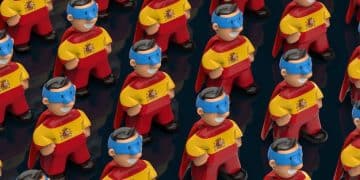Comic Book Collecting for Beginners: Your Step-by-Step Guide

Comic book collecting for beginners involves understanding grading, preservation, key issues, and building a collection that aligns with your interests and budget, ensuring both enjoyment and potential investment.
Embarking on the world of comic book collecting can seem daunting, but with the right guidance, anyone can start building their own impressive collection. This comic book collecting for beginners: a step-by-step guide will equip you with the knowledge to navigate the ins and outs of this exciting hobby.
Understanding the Basics of Comic Book Collecting
Before diving into the world of collecting, it’s essential to grasp some fundamental concepts. This includes understanding what makes a comic valuable, the different eras of comics, and the key terms you’ll encounter as a collector. Knowing these basics will help you make informed decisions and build a collection you’re truly passionate about.
What Makes a Comic Book Valuable?
Several factors contribute to a comic book’s value. These include its age, rarity, condition, and the demand for it among collectors. Key issues, such as first appearances of popular characters, often command high prices.
Key Terminology for Collectors
Familiarize yourself with terms like “first appearance,” “variant cover,” “key issue,” “grading,” and “slabbed.” Understanding these terms will enable you to communicate effectively with other collectors and make informed purchasing decisions.
- First Appearance: The initial appearance of a character which drives collectibility.
- Variant Cover: Alternative cover art, creating sought-after collectibles.
- Key Issue: Significant story event triggering value in the comic.
Comprehending what comprises the heart of an issue assists novice collectors in assessing their picks. It’s important to consider that value is subjective; what is precious to one collector might not resonate as much with somebody else.

Grading and Condition: A Collector’s Guide
The condition of a comic book is a major factor in determining its value. Grading companies use a standardized scale to assess the condition of comics, ranging from Mint (highest grade) to Poor (lowest grade). Understanding this grading scale is crucial for evaluating the value of your comics.
Understanding the Grading Scale
The grading scale generally runs from 0.5 (Poor) to 10 (Gem Mint). Factors such as spine creases, discoloration, tears, and missing pages are considered when assigning a grade.
The Role of Third-Party Grading
Companies like CGC (Certified Guaranty Company) and PGX (Professional Grading eXperts) offer third-party grading services. They assess the condition of a comic and encapsulate it in a protective case, known as a “slab,” along with a label indicating the grade.
- CGC: Certified Guaranty Company, the leading comic grading service.
- PGX: Professional Grading eXperts, offers comic grading and encapsulation.
- Slabbed Comics: Encapsulated comics provide protection and verified grade.
Assessing the condition of comics and the role of third-party grading is fundamental. While subjective personal assessments have merit, the market recognizes and utilizes industry-recognized grading standards.
Setting a Budget and Finding Comics
Collecting comic books can be an expensive hobby, so it’s important to set a budget and stick to it. There are numerous places to find comics, from local comic shops to online retailers. Knowing where to look and how to negotiate prices can help you build your collection without breaking the bank.
Establishing Your Spending Limits
Determine how much you can realistically afford to spend on comics each month. Factor in expenses such as protective supplies (bags, boards, and boxes) and potential grading costs.
Where to Buy Comics
Explore local comic shops, conventions, online marketplaces (eBay, MyComicShop), and social media groups. Each venue offers different opportunities and price points.

Preserving and Storing Your Collection
Proper storage is essential for preserving the condition of your comic books. Factors such as humidity, temperature, and sunlight can damage comics over time. Investing in the right supplies and storage methods will help ensure your collection remains in good condition for years to come.
Essential Storage Supplies
Purchase acid-free bags and boards to protect individual comics. Store bagged and boarded comics in comic-specific boxes designed to prevent damage.
Creating a Safe Storage Environment
Store your comics in a cool, dry place away from direct sunlight. Avoid areas prone to temperature fluctuations or high humidity, such as attics and basements.
- Acid-Free: The bags and boards required to avoid comic damage.
- UV Light: Damaging wavelengths of sunlight.
- Climate Control: Humidity influences the aging and preservation of comics.
Understanding the impact of environmental conditions on your comics, the tools and environments you use to protect them, helps ensure your collection will be in good condition in years to come.
Identifying Key Issues and Potential Investments
Many collectors are interested in acquiring key issues or comics with potential investment value. Researching market trends, understanding historical significance, and recognizing factors that drive demand can help you make informed decisions about which comics to add to your collection.
Researching Market Trends
Follow comic book news, auction results, and price guides to stay informed about current market trends. Pay attention to announcements of upcoming films or TV shows featuring comic book characters.
Recognizing Long-Term Value
Consider factors such as character popularity, historical significance, and scarcity when evaluating a comic’s long-term potential. Focus on comics that are likely to remain in demand among collectors.
Building Your Collection: Focusing on Your Interests
Ultimately, the most rewarding aspect of comic book collecting is building a collection that reflects your personal interests and passions. Whether you’re drawn to a particular genre, character, or artist, focus on acquiring comics that you enjoy and that bring you joy.
Collecting on Your Own Terms
Although value can be important, focusing on titles and characters you enjoy will lead to contentment. This maximizes personal enjoyment.
A Personal Connection Matters
A comic linked to your youth or one you have a strong affinity toward can transform the collecting experience into something very special.
- Personal Taste: Focus on what you enjoy reading and collecting.
- Nostalgia: Embrace comics that evoke fond memories and emotions.
- Knowledge is key: Knowing the fundamentals of comic book collecting helps ensure a positive experience.
Connecting reading and collecting and discovering artists and genres that resonate transforms a pastime into a treasure. Consider that every comic has unique worth and meaning.
| Key Aspect | Brief Description |
|---|---|
| 💰 Budgeting | Decide how much you can spend monthly. |
| 🔎 Grading | Inspect condition using standardized grading. |
| 🛡️ Protecting | Acid-free bags and boards keep comics safe. |
| 📚 Collecting | Focus on the comic books that personally interest you. |
Frequently Asked Questions
▼
A comic book’s value is primarily determined by its age, condition (or ‘grade’), rarity, and overall demand. Key issues, like first appearances, tend to drive up the price. Accurate grading also plays a significant role.
▼
Use acid-free bags and boards to protect each comic. Store them in comic-specific boxes in a cool, dry place, away from direct sunlight. Avoid areas with high humidity or fluctuating temperatures to prevent damage.
▼
“Slabbed” means a comic has been graded by a third-party company (like CGC or PGX) and sealed in a protective, hard plastic case (“slab”). This provides verified condition and helps with preservation, increasing collector confidence.
▼
Popular spots to purchase comics include local comic shops, conventions, online marketplaces such as eBay and MyComicShop, and social media groups. Each offers different selections and price points.
▼
Assess your monthly income and expenses to determine what you can comfortably spend. Include costs for comics, storage supplies, and potential grading fees. Stick to this budget to avoid overspending.
Conclusion
With the insights from this step-by-step guide, you’re now well-prepared to begin your journey into comic book collecting for beginners. Remember, the best comic book collection is one that brings you personal joy and satisfaction. Enjoy the search, and happy collecting!





